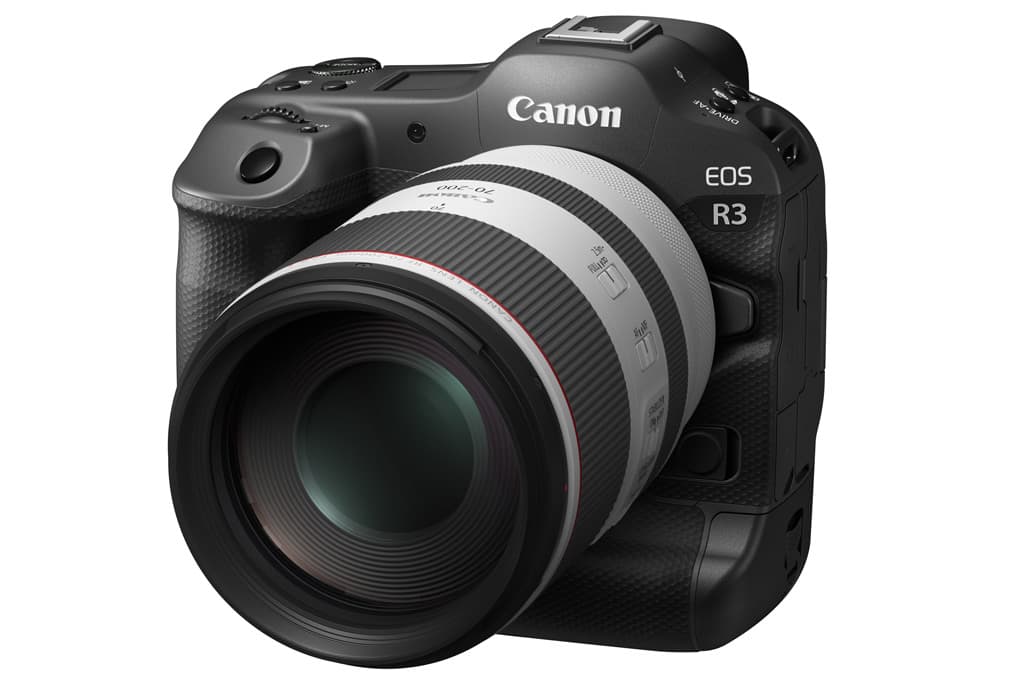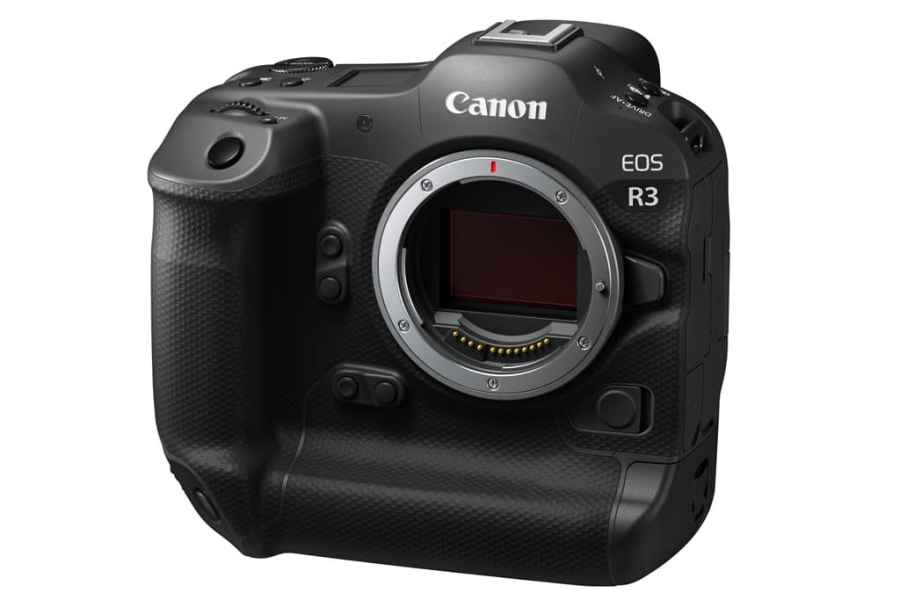The Canon EOS R3 is Canon’s flagship mirrorless camera, and as such we thought it would be worthwhile to have a look at it in detail and compare it to Sony’s flagship mirrorless cameras, so let’s dive right in and compare the Canon EOS R3 Vs Sony Alpha 1 Vs Sony A9 II, three flagship mirrorless cameras, all designed for high-speed continuous shooting with sports photographers in mind.
15 things you need to know about the Canon EOS R3 compared to the Sony Alpha 1 and A9 II
Another camera that would be worth looking at in a future comparison would be the Nikon Z9, but as this has not yet been officially announced with full specifications, we cannot compare it yet.
Make sure to read our Canon EOS R3 Hands-On Preview
Canon EOS R3 vs Sony Alpha 1 – Sensor on display
Canon EOS R3 Vs Sony Alpha 1 Vs A9 II Sensor Technology and Features
Image Sensor:
- R3: 24.1MP FF stacked BSI CMOS sensor
- Sony A1: 50.1MP FF stacked BSI CMOS sensor
- Sony A9 II: 24MP FF stacked BSI CMOS sensor
The Canon EOS R3 has a 24MP sensor, which Canon say is the ideal resolution for sports photographers who need to send images as quickly as possible to news agencies. Often the first person to get the photo in, is the one who gets published.
What is a stacked CMOS sensor? A stacked sensor has internal memory built-in that enables faster readout from the sensor, meaning the camera can shoot at a faster continuous shooting speed. BSI = Backside Illuminated Sensor, giving improved noise performance compared to non-BSI sensors.
Image stabilisation:
- R3: 5-axis sensor-shift, up to 8 stops, with optically stabilised lens
- A1: 5-axis sensor-shift, 5.5 stops
- A9 II: 5-axis sensor shift, up to 5 stops
Canon’s 5-axis image stabilisation system moves the sensor to counter any camera shake, and this works in combination with Canon’s lenses with Optical Image Stabilisation, giving up to 8 stops of image stabilisation. Sony’s system works in the same way, but Sony only quote the amount of stabilisation for the camera with a lens without optical image stabilisation. The Sony Alpha 1 uses the sensor-shift system to create high-resolution images using multiple shots, this means you can put together high-resolution images on your computer later, giving you 200MP images.
ISO range:
- R3: 50-204800 (extended)
- Sony A1: 50-102400 (extended)
- A9 II: 50-204800 (extended)
The ISO range available from all cameras is very good, and as with most cameras, sticking to the lower ISO speeds is likely to give you the best results. It’s unlikely you’ll need to use the highest ISO speeds, but there could be situations where you need better low-light performance, and it’s likely that the 24MP cameras are going to give better results than the 50MP Sony Alpha 1.
Canon EOS R3 Vs Sony Alpha 1 Vs A9 II Shooting and Focus
Continuous shooting:
- R3: 30fps (electronic) with AF/AE tracking, 150frame buffer, or 1000 when shooting 12fps mechanical shutter
- A1: 30fps (electronic) with AF/AE tracking, 10fps mechanical shutter, up to 238/400 raw/JPEG shots (JPEG Fine L)
- A9 II: 20fps (electronic) with AF/AE tracking, 10fps mechanical shutter, up to 239/361 raw/JPEG shots without slowdown (JPEG Extra fine L)
Both the Canon EOS R3 and Sony Alpha 1 offer 30fps continuous shooting with AF/AE tracking, however what’s particularly impressive about the Sony Alpha 1 is that this is at double the resolution, as the camera is shooting 50MP images, compared to the EOS R3’s 24MP images.
Shutter speeds available:
- R3: 30-1/8000s (mechanical), 1/64000s (electronic)
- A1: 30s – 1/8000s (mechanical), 1/32000s (electronic)
- A9 II: 30s – 1/8000s (mechanical), 1/32000s (electronic)
All cameras offer the same shutter speeds when using the mechanical shutter, and the Sony cameras offer up to 1/32000s when using the electronic shutter. The EOS R3 goes one step further by offering shutter speeds up to 1/64000s!
AF system:
- R3: 4779 AF points – phase detection
- A1 – 759 AF points – phase detection, 425 contrast detection
- A9 II – 693 AF points – phase detection, 425 contrast detection
The Canon EOS R3 features 4779 AF points, phase detection, with eye-detection AF for both animals (including birds) and humans, plus vehicle detection. It also features eye-control focus, where the camera will focus on the subject that you are looking at. Focus is sensitive down to -7.5EV with an f/1.2 lens.
The Sony A1 features 759 AF points, phase detection, covering 92% of the frame, and is sensitive down to -4EV with f/2.0 lens. Eye-detection AF works with humans, animals and birds for stills photography. Video is limited to humans only. You also need to select before shooting whether you want to shoot humans, animals, or birds, as the camera does not automatically detect these without first being told what you are shooting.
The Sony A9 II feature 693 AF points, phase detection, 93% coverage of the frame, sensitive down to -3EV with f/2.0 lens. Eye-detection AF works with humans, and animals, but not birds. You also need to select between animals and humans before shooting.
Canon EOS R3 Vs Sony Alpha 1 Vs A9 II Screen, Viewfinder and Video
Screen:
- R3: 3.2inch 4.2m dot fully articulated touchscreen
- A1: 3.0inch 1.44m dot tilting touchscreen
- A9 II: 3.0inch 1.44m dot tilting touchscreen
The high-resolution of the Canon EOS R3 screen, at 4.2m dots and the ability to move the screen to any position you want simply goes to show how dated the screen is in the Sony Alpha cameras, particularly the Sony Alpha 1 which, as a flagship £6499 camera, should have a much better screen.
Viewfinder:
- R3: 5.76M dot, 0.76x magnification, upto 120fps refresh
- A1: 9.4M dot, 0.90x magnification, upto 120/240fps refresh (normal/reduced size)
- A9 II: 3.69M dot, 0.78x magnification, upto 120fps refresh
The Sony Alpha 1 clearly has the highest resolution, and largest view, as well as offering the fastest refresh rates, with the ability to increase the refresh rate to 240fps albeit at a reduced size with 0.7x magnification. The Canon EOS R3 remains very impressive though, with an electronic viewfinder (EVF) that has a 5.76M dot resolution, and 0.76x magnification, it’s likely to give an excellent view.
Video:
- R3: 6K up to 60fps, 4K UHD up to 120fps
- A1: 8K 30fps, 4K 120fps
- A9 II: 4K UHD, upto 30fps
With 6K video recording at upto 60fps, and 4K UHD video at upto 120fps, the Canon EOS R3 will keep most videographers very happy, however, for those looking for 8K video recording, they’ll need to look at the Sony Alpha 1 or the Canon EOS R5. A 24mp sensor simply doesn’t have a high enough resolution to support 8K video recording.

Canon EOS R3 Vs Sony Alpha 1 Vs A9 II Memory, Ports and Connectivity
Memory card slots:
- R3: Dual: 1x CFexpress type B, 1x UHS-II SD
- A1: Dual UHS-II SD / CFexpress type A
- A9 II: Dual UHS-II SD card slots
Support for SD cards comes with all cameras, and they support UHS-II SD card, which give quicker read and write speeds. CFexpress cards give even quicker read/write speeds, as well as more solid construction, but these cards tend to be noticeably more expensive than SD cards.
Ports and Connectivity:
- R3: 5GHz Wi-Fi, Bluetooth 5.0, Gigabit Ethernet port, FTP, Microphone, Headphone, HDMI, USB
- A1: 5GHz Wi-Fi, Bluetooth 5.0, NFC, Gigabit Ethernet port, FTP, Microphone, Headphone, HDMI, USB C 3.2 Gen 2 (10GB)
- A9 II: 5GHz Wi-Fi, Bluetooth 4.1, NFC, Gigabit Ethernet port, FTP, Microphone, Headphone, HDMI, USB
All cameras offer various connectivity options, with the newer Canon EOS R3 and Sony Alpha 1 benefitting from Bluetooth 5.0. The Sony cameras support NFC which can make connecting to a smartphone quicker, but not having it on the EOS R3 is no big loss. Being able to connect to ethernet will be useful for sports and news photographers, whereas HDMI connection will be useful for video.
Battery life:
- R3: 860 shots (LCD), 620 shots (EVF)
- A1: 530 shots (LCD), 430 shots (EVF)
- A9 II: 690 shots (LCD), 500 shots (EVF)
The Canon EOS R3 offers the best battery life out of the cameras here, but none of them match the more impressive battery life offered by professional DSLRs, such as the Canon EOS-1D X Mark III, which offers up to 2850 shots (using the OVF).

Canon EOS R3 Vs Sony Alpha 1 Vs A9 II Body
Size, Weight and weather-sealing:
- R3: 150×142.6×87.2mm, weight 1015g with battery and memory card
- A1: 128.9×96.9×80.8mm, weight 737g with battery and memory card
- A9 II: 128.9×96.4×77.5mm, weight 673g with battery and memory card
All cameras are weather-sealed, as you would expect from a professional camera designed for sports and wildlife photography, but the Canon EOS R3 is the only model to offer the “Professional” DSLR styling with integrated vertical grip. You can, of course, add a vertical grip to the Sony cameras, but this will add to the price, and isn’t included as standard. If you’re looking for a smaller camera, then the Sony cameras definitely cater to this market.
Price:
- R3: £5879 body only (RRP)
- A1: £6499 body only (RRP)
- A9 II: £4800 body only (RRP) – now available for £4199 body only
Whilst all these cameras cost a lot of money, there is a £2300 price difference between the most expensive and the cheapest here. This money could be put towards a number of lenses, or you could save yourself a lot of money by choosing the Sony Alpha 9 II, if you don’t need 30fps continuous shooting.
Other differences:
- R3: Top LCD panel, plus a new Multi-Function Shoe supports new accessories
- A1: No top LCD panel. Multi-shot high-resolution mode
- A9 II: No top LCD panel
It may or may not matter to you, but the Sony cameras do not feature a top LCD panel, whereas the Canon EOS R3 does. This gives you shooting information at a glance, and you can see what the camera settings are without having to pick up the camera, this could be useful when a camera is on a tripod, and you might not want to tilt the screen out, in fear of it being damaged by a rougue football or other flying debris. The Canon EOS R3 introduces a new Multi-Function Shoe to support new accessories, including a Directional Stereo Microphone, and Speedlite Transmitter. The Sony Alpha 1, and A9 II both feature a “Multi Interface Shoe” with additional electronic contact, like the Canon system, giving support for additional accessories, including microphone and audio adatpers.








